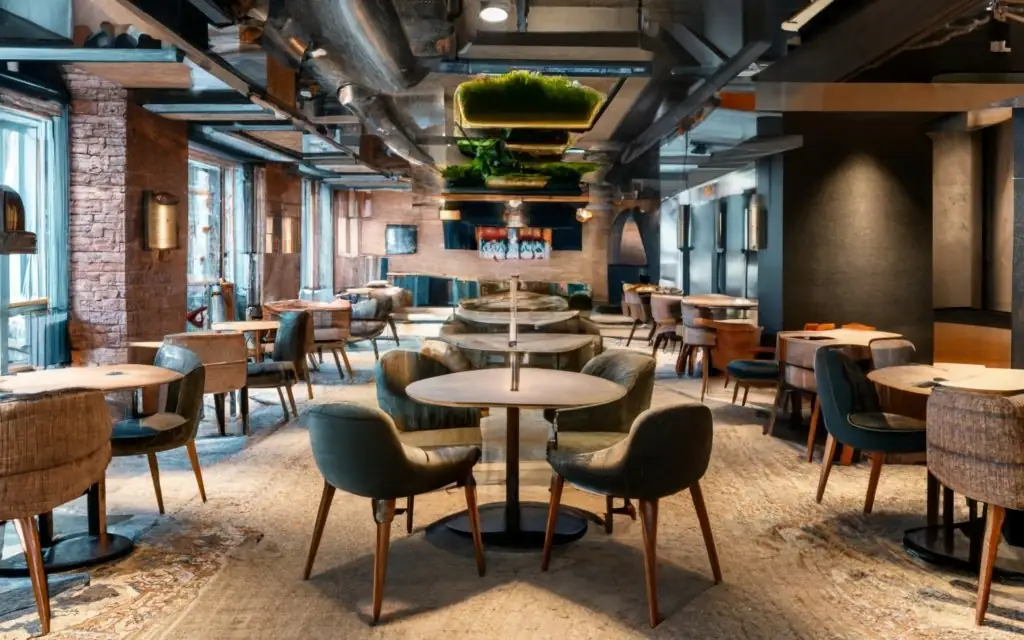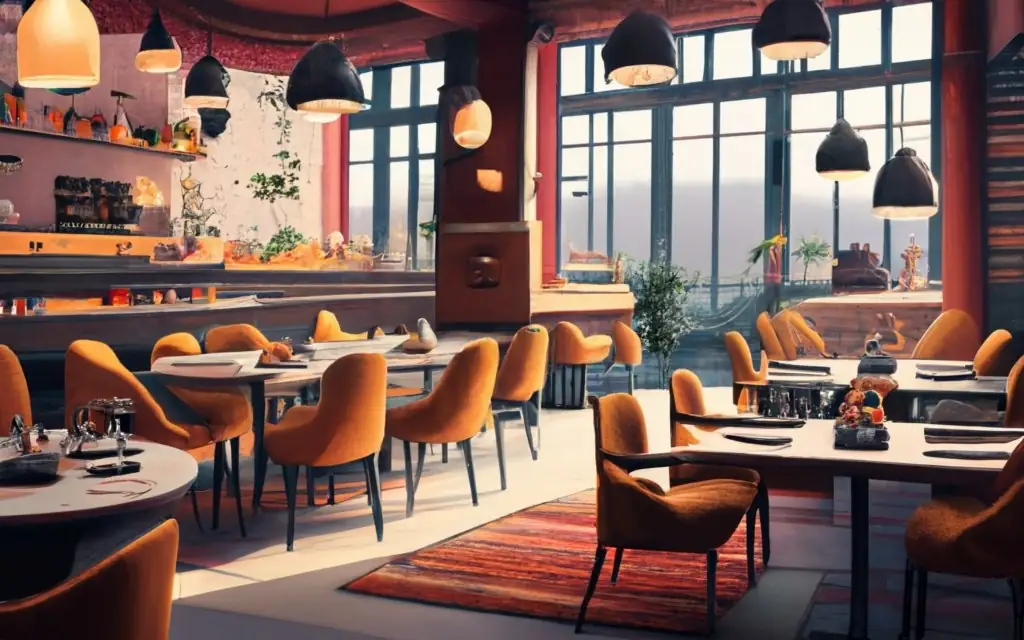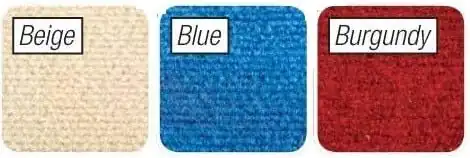Last updated on October 28th, 2023 at 01:13 pm
When you step into a restaurant, the first thing that often catches your eye is the decor – from the choice of furniture to the color scheme on the walls.
But what about the flooring? In many dining establishments, carpets play a significant role in creating the right ambiance and dining experience. In this article, we’ll delve into the world of “carpet in restaurants” and explore the various aspects and questions surrounding this topic. So, let’s roll out the carpet, shall we?
Introduction: Why Would a Restaurant Have Carpet?
Restaurants make a deliberate choice when it comes to flooring, and carpets are often preferred for several practical reasons.
Practical Reasons for Using Carpets in Restaurants
- Noise Reduction: Carpet can absorb sound and reduce noise levels, creating a more pleasant dining environment. This is particularly important in fine dining restaurants where conversation and ambiance are paramount.
- Comfort: Carpets offer a soft and comfortable underfoot feel. This added comfort can contribute to an overall enjoyable dining experience for patrons.
- Aesthetics: Carpets can be visually appealing, adding warmth and character to the restaurant’s interior. They come in a wide range of colors and patterns to match the decor.
- Safety: Carpets provide a non-slip surface, enhancing safety for both customers and staff. This is especially crucial in busy kitchens and bars.
- Acoustics: Carpets can improve acoustics by reducing echoes and sound reverberation. This is beneficial for maintaining a peaceful atmosphere.
Cleanliness and Hygiene
One common concern is whether carpets in restaurants compromise cleanliness and hygiene. It’s essential to note that restaurants take specific measures to ensure cleanliness despite using carpets. High-traffic areas may have hard flooring like tiles, while carpets are strategically placed in dining areas. Regular cleaning routines, including vacuuming and steam cleaning, help maintain hygiene standards.

Types of Carpets Suitable for Restaurants
The type of carpet chosen for a restaurant largely depends on the restaurant’s style and requirements.
Carpet Types and Suitability
- Berber Carpet: Durable and easy to clean, Berber carpets are a popular choice for high-traffic areas like entryways.
- Cut Pile Carpet: These carpets have a plush, luxurious feel and are often used in fine dining establishments.
- Indoor/Outdoor Carpet: Suitable for restaurants with outdoor seating, these carpets are weather-resistant and easy to clean.
- Carpet Tiles: Versatile and easy to replace, carpet tiles are a practical choice for areas with a high risk of spills or stains.
Impact on Ambiance and Atmosphere
Carpets have a significant impact on the ambiance and atmosphere of a restaurant.
Creating the Right Atmosphere
The choice of carpet color, pattern, and texture can contribute to the overall decor and ambiance. Darker colors may create an intimate and cozy atmosphere, while lighter shades can make the space feel more open and airy. Patterned carpets can add a touch of sophistication or whimsy, depending on the restaurant’s theme.

Drawbacks of Using Carpets in Restaurants
While carpets offer many benefits, there are drawbacks to consider.
Potential Disadvantages
- Maintenance Challenges: Carpets require regular maintenance, including vacuuming and professional cleaning, to prevent staining and odors.
- Stains: Spills and stains are more visible on carpets, and they may require immediate attention to avoid permanent damage.
- Allergens: Carpets can trap allergens, affecting air quality. This can be a concern for individuals with allergies.
- Cost: Initial installation costs and ongoing maintenance can be higher compared to hard flooring options.
Cleaning Frequency and Methods
Proper cleaning and maintenance are essential to keep restaurant carpets in top condition.
Recommended Cleaning Practices
- Daily Vacuuming: High-traffic areas should be vacuumed daily to remove dirt and debris.
- Regular Deep Cleaning: Schedule professional deep cleaning at least once every three to six months to address stains and maintain freshness.
Impact on Acoustics and Noise Levels
One of the significant advantages of restaurant carpets is their ability to influence noise levels.
Noise Reduction
Carpets absorb sound, reducing noise levels and creating a more comfortable dining environment. This is particularly important in busy restaurants where patrons and staff need to converse without distraction.
Restaurant Styles and Carpet Choices
The type of restaurant and its cuisine can influence the choice of carpets.
Customization for Different Styles
- Fine Dining Restaurants: These establishments often opt for plush, luxurious carpets that add to the upscale ambiance.
- Cafes and Bistros: More casual restaurants might choose low-pile carpets or carpet tiles that are easier to clean.
- Outdoor Seating Areas: Restaurants with outdoor seating may choose weather-resistant carpets for durability.
Design Considerations
Carpet design plays a crucial role in the overall restaurant decor.
Impact of Carpet Design
The color, pattern, and texture of carpets should align with the restaurant’s theme and ambiance. For example, a rustic restaurant might opt for earthy tones and natural textures, while a modern eatery could embrace bold patterns and vibrant colors.
Maintaining and Caring for Restaurant Carpets
Proper care is essential to extend the lifespan of restaurant carpets.
Carpet Maintenance Tips
- Immediate Stain Treatment: Train staff to respond promptly to spills and stains to prevent permanent damage.
- Regular Vacuuming: Daily vacuuming helps remove surface dirt and prevents it from settling into the carpet fibers.
- Professional Cleaning: Schedule professional deep cleaning to maintain cleanliness and freshness.
Eco-Friendly Carpet Options
For environmentally-conscious restaurants, there are eco-friendly carpet choices.
Sustainable Options
- Recycled Materials: Carpets made from recycled materials are an eco-friendly choice.
- Low VOC Carpets: These carpets emit fewer volatile organic compounds, improving indoor air quality.
- Carpet Tiles: Easily replaceable, carpet tiles reduce waste and are a sustainable option.
A Historical Perspective
Carpets in restaurants have a history that spans centuries.
Historical Evolution
Carpets were initially a symbol of luxury and prestige in royal courts. Over time, they made their way into everyday dining establishments, enhancing the dining experience. Today, carpets continue to play a significant role in creating memorable dining atmospheres.
Are Carpets Suitable for Busy Restaurants?
The suitability of carpets for busy restaurants is a topic that raises a valid question for restaurant owners and managers. While carpets offer several advantages, such as noise reduction, comfort, and aesthetics, their use in busy dining establishments needs to be carefully considered.
It’s essential to consider factors such as maintenance, cost, and the specific needs and style of the restaurant. Some restaurants may opt for a combination of hard and carpeted flooring to strike a balance between comfort, aesthetics, and practicality. Ultimately, the suitability of carpets in busy restaurants depends on the restaurant’s unique requirements and priorities.
Best Carpets for Commercial Restaurants
Choosing the best carpet for a commercial restaurant involves considering factors like durability, ease of cleaning, and style. Here are some popular carpet options that are well-suited for commercial restaurants:
- Berber Carpet: Berber carpets are known for their durability and resistance to wear and tear, making them an excellent choice for high-traffic areas in commercial restaurants. They have a looped construction that can withstand heavy foot traffic and are relatively easy to maintain.
- Commercial-Grade Cut Pile Carpet: Cut pile carpets, with their soft and plush texture, are often used in upscale restaurants. They offer a luxurious feel and can enhance the dining experience. Look for commercial-grade cut pile carpets with stain-resistant treatments to ensure they withstand spills and stains.
- Indoor/Outdoor Carpet: Indoor/outdoor carpets are designed to withstand exposure to the elements, making them a suitable choice for restaurants with outdoor seating areas. These carpets are durable, weather-resistant, and easy to clean.
- Carpet Tiles: Carpet tiles are versatile and easy to replace. They are ideal for areas with a high risk of spills and stains. If a portion of the carpet becomes stained or damaged, you can replace individual tiles rather than the entire carpet.
- Low-Pile Carpets: Low-pile carpets are easy to clean and maintain, making them a practical choice for restaurants. They are less likely to trap dirt and are a good option for casual or fast-food establishments.
- Custom-Designed Carpets: For a truly unique and branded look, some commercial restaurants opt for custom-designed carpets. These carpets can feature the restaurant’s logo, color scheme, or specific patterns that align with the theme and decor.
When choosing the best carpet for your commercial restaurant, it’s important to consider the following factors:
- Durability: Commercial restaurants experience high foot traffic, so select carpets that are durable and resistant to wear and tear.
- Stain Resistance: Look for carpets treated with stain-resistant coatings to make cleanup easier.
- Aesthetics: Consider the overall theme and ambiance of your restaurant. The carpet should complement the decor and style.
- Maintenance: Assess the level of maintenance required and ensure it aligns with your restaurant’s cleaning routine.
- Safety: Safety is paramount. Ensure the carpet provides a non-slip surface to prevent accidents.
- Budget: Evaluate the initial installation costs as well as the long-term maintenance expenses.
- Local Regulations: Be aware of local health and safety regulations that may impact your choice of restaurant flooring.
Ultimately, the best carpet for your commercial restaurant will depend on your specific needs, style, and priorities. It’s recommended to work with a flooring professional who can provide guidance based on your restaurant’s unique requirements and preferences.
Best Waterproof Vinyl Carpets for Restaurants
For restaurants with a high risk of spills, waterproof vinyl carpets can be an excellent choice.
These carpets offer the benefits of both vinyl and carpet, providing a comfortable and visually appealing surface while also being highly resistant to moisture and stains. When selecting the best waterproof vinyl carpets for restaurants, consider factors such as durability, aesthetics, and ease of maintenance. Here are some options to consider:
- Luxury Vinyl Plank (LVP) or Luxury Vinyl Tile (LVT): Luxury vinyl planks and tiles mimic the look of natural wood or stone while offering waterproof properties. They are easy to clean and maintain, making them ideal for restaurant dining areas.
- Sheet Vinyl with Waterproof Backing: Some sheet vinyl products come with a waterproof backing that prevents moisture from seeping through to the subfloor. This type of vinyl is available in a variety of patterns and designs.
- Vinyl Composite Tile (VCT): VCT is a durable and waterproof flooring option suitable for high-traffic areas in restaurants. It can be easily cleaned and maintained, making it a cost-effective choice.
- WPC (Wood Plastic Composite) Vinyl: WPC vinyl combines the durability of vinyl with the appearance of hardwood. It’s waterproof, easy to clean, and can withstand the demands of a busy restaurant.
- SPC (Stone Plastic Composite) Vinyl: SPC vinyl is engineered to look like natural stone or ceramic tiles. It is highly resistant to moisture and offers a realistic appearance. It’s an excellent choice for both appearance and performance.
- Carpet Tiles with Waterproof Backing: Some carpet tiles are designed with a waterproof backing, combining the comfort of carpet with waterproof properties. These are practical for restaurant dining areas.
When selecting waterproof vinyl carpets for your restaurant, consider the following factors:
- Durability: Look for vinyl carpets with a wear layer that can withstand heavy foot traffic without showing signs of wear and tear.
- Aesthetics: Choose a style and design that complements the decor and ambiance of your restaurant.
- Ease of Maintenance: Ensure the vinyl carpet is easy to clean and resistant to stains.
- Cost: Evaluate your budget and consider the long-term costs, including installation and maintenance.
- Installation: Consult with a professional to ensure proper installation, especially if the subfloor may be prone to moisture.
- Safety: Even though vinyl is waterproof, it’s essential to select carpets with anti-slip properties to prevent accidents.
- Warranty: Check for manufacturer warranties that cover waterproof features and durability.
Waterproof vinyl carpets can provide the best of both worlds, offering the comfort of traditional carpeting and the practicality of waterproof flooring. When chosen wisely, they can contribute to a welcoming and low-maintenance dining environment for your restaurant patrons.
Why Do Some Restaurants Have Tile Floors?
While carpets are popular in many restaurants, some opt for tile floors, which have their own set of advantages, including ease of cleaning and durability.
Table: Carpet Types and Their Suitability
| Carpet Type | Suitability |
|---|---|
| Berber Carpet | High-traffic areas, durability |
| Cut Pile Carpet | Fine dining, plush feel |
| Indoor/Outdoor Carpet | Outdoor seating, weather-resistant |
| Carpet Tiles | Spills and stains, easy replacement |
In conclusion, the choice of using carpets in restaurants is a deliberate one, influenced by practical considerations, aesthetics, and the desired dining experience. While carpets offer numerous advantages, including noise reduction and comfort, they also come with maintenance challenges. Proper care and a thoughtful approach to design can ensure that carpets enhance the ambiance and atmosphere of a restaurant. Ultimately, whether a restaurant opts for carpets or other flooring options, it’s a crucial element in creating a memorable dining experience for patrons.
For authoritative information on restaurant flooring and maintenance, consider these sources:
This article has explored the various aspects of using carpets in restaurants, from their practical advantages to design considerations and maintenance. Whether you’re a restaurant owner or a curious diner, understanding the role of carpets in creating a unique dining experience is essential.




